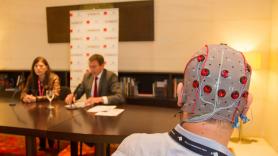1. Electric brain stimulation: a panacea ... with caveats
The brain is, in large part, a sort of black box: we know what goes in and what comes out but not what goes on inside. One advantage is that, in general, what goes on uses electric signals. The fact that these signals can be modified opens up a whole range of possible applications. This could be done in several different ways: by implanting electrodes into specific areas of the brain or by applying electricity or electromagnetic currents from the outside.
The use of electric stimulation is most common in patients with Parkinson who have symptoms that can no longer be controlled using pharmacological treatments. But its applications don’t end there: the FDA (US regulatory agency) has also approved it to treat certain types of epilepsy, depression and obsessive-compulsive disorder, as long as they don’t respond to standard treatments. In Europe, these applications are starting to become more frequent in clinical trials. The FDA has also approved transcraneal magnetic stimulation, in which current is applied superficially and doesn’t require surgery, for resistant depression and certain types of migraines.
Nevertheless, breakthroughs aren’t coming as fast as experts would like. Jordi Rumiá, neurosurgeon at Hospital Clínic Barcelona, explains “Applications have spread but in essence, things haven’t changed in the past twenty years.” Moreover, regarding Parkinson, he said, “We know it works, but we still don’t know why.” Rumiá advocates for greater collaboration between basic and clinical scientists and believes the use of these applications shouldn’t be put off just because we don’t know exactly how they work, as long as they offer an acceptable level of safety. ”It took one hundred years before we understood how aspirin works, but people didn’t stop taking it,” he says.
The use of electric stimulation in healthy patients sparks even more debate. Marom Bikson –co-director of the Translational Medical Device Development Program and Neural Engineering Group at the New York Center for Biomedical Engineering– believes that “Ten years from now most people will be wearing performance-enhancing devices on their heads.” This is one thing not everyone agrees on. For Sánchez-Vives, although this is a possibility, “We don’t know their true efficacy or middle and long-term effects. Stimulation could interfere with normal neuronal activity and affect the brain’s plasticity, which isn’t always positive.”
There are studies that link the use of electric stimulation (in this case using a helmet, without the need for surgically implanted electrodes) to improve memory, motor abilities, reading and math skills... even to boost feelings of compassion. Sánchez-Vives believes these studies don’t always isolate the possible placebo effect and, furthermore, many more that don’t yield positive results are never published. Bikson accepts that there are many doubtful applications: “When someone says that something is a cure-all, the natural reaction is to say it really cures nothing.” But, even though there may be a placebo effect, she defends the use of this technology with the following comparison: “It’s like wondering why weights work for so many sports: because they allow for specific types of training.” For Bikson, electrically stimulating the right area after working it intensely would help reinforce the activity, because ”it specifically works on the neurons that are already active.” However this is one thing Arthur Konnerth, team leader at the Munich Excellence Clusters CIPSM and SyNergy, doesn’t fully agree with. “These results have been achieved in laboratory experiments, but they may not be able to be repeated in vivo, under normal conditions,” he warns.
Identifying consciousness after a coma
Some coma patients “emerge” from their condition and go into what is called a “vegetative state”. They open their eyes but don’t seem to recover real consciousness or respond to external stimuli. Nevertheless, they may have traces of perception and desires that are hidden, unexplorable.
In 2006, a study showed that when some patients were asked to think about a tennis match or move through their homes mentally, the areas of their brains responsible for these activities were activated. Meaning that they heard the orders, understood them and executed them. They still take in what goes on around them. Now a new experimental method has used transcranial magnetic stimulation to improve these states. It sends a powerful stimulus and then measures the complexity with which the brain responds, which can be quantified and broken down into different degrees and states of consciousness. In the words of Marcello Massimini, professor of physiology at the University of Milan and head of the study, “it’s like calling the brain and listening to the echo.”



